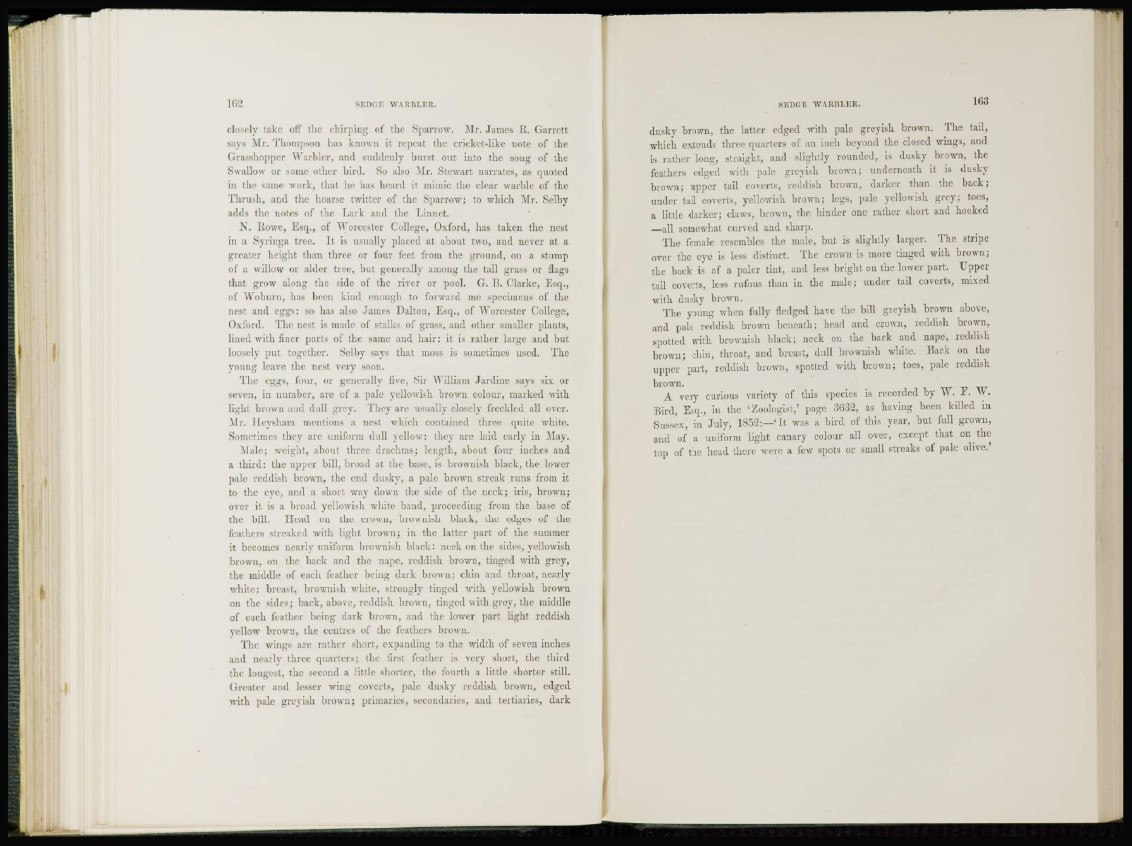
SEDGE WARBLER.
closely take off the chirping of the Sparrow. Mr. James It. Garrett
says Mr. Thompson has known it repeat the cricket-like note of the
Grasshopper Warbler, and suddenly burst out into the song of the
Swallow or some other bird. So also Mr. Stewart narrates, as quoted
in the same work, that he has heard it mimic the clear warble of the
Thrush, and the hoarse twitter of the Sparrow; to which Mr. Selby
adds the notes of the Lark and the Linnet.
N. Howe, Esq., of Worcester College, Oxford, has taken the nest
in a Syringa tree. It is usually placed at about two, and never at a
greater height than three or four feet from the ground, on a stump
of a willow or alder tree, but generally among the tall grass or flags
that grow along the side of the river or pool. G. B. Clarke, Esq.,
of Woburn, has been kind enough to forward me specimens of the
nest and eggs: so has also James Dalton, Esq., of Worcester College,
Oxford. The nest is made of stalks of grass, and other smaller plants,
lined with finer parts of the same and hair: it is rather large and but
loosely put together. Selby says that moss is sometimes used. The
yroung leave the nest very soon.
The eggs, four, or generally five, Sir William Jardiue says six or
seven, in number, arc of a pale yellowish brown colour, marked with
light brown and dull grey. They are usually closely freckled all over.
Mr. I [eysham mentions a nest which contained three quite white.
Sometimes they arc uniform dull yellow: they are laid early in May.
Male; weight, about three drachms; length, about four inches and
a third: the upper bill, broad at the base, is brownish black, the lower
pale reddish brown, the end dusky, a pale brown streak runs from it
to the eye, and a short way down the side of the neck; iris, brown;
over it is a broad yellowish white band, proceeding from the base of
the bill. Head on the crown, brownish black, the edges of the
feathers streaked with light brown; in the latter part of the summer
it becomes nearly uniform brownish black: neck on the sides, yellowish
brown, on the back and the nape, reddish brown, tinged with grey,
the middle of each feather being dark brown; chin and throat, nearly
white; breast, brownish white, strongly tinged with yellowish brown
on the sides; back, above, reddish brown, tinged with grey, the middle
of each feather being dark brown, and the lower part light reddish
yellow brown, the centres of the feathers brown.
The wings are rather short, expanding to the width of seven inches
and nearly three quarters; the first feather is very short, the third
the longest, the second a little shorter, the fourth a little shorter still.
Greater and lesser wing coverts, pale dusky reddish brown, edged
with pale greyish brown; primaries, secondaries, and tertiaries, dark
SEDGE WARBLER. 163
dusky brown, the latter edged with pale greyish brown. The tail,
which extends three quarters of an inch beyond the closed wings, and
is rather long, straight, and slightly rounded, is dusky brown, the
feathers edged with pale greyish brown; underneath it is duskybrown;
upper tail coverts, reddish brown, darker than the back;
under tail coverts, yellowish brown; legs, pale vellowish grey; toes,
a little darker; claws, brown, the hinder one rather short and hooked
—all somewhat curved and sharp.
The female resembles the male, but is slightly larger. The stripe
over the eye is less distinct. The crown is more tinged with brown;
the back is of a paler tint, and less bright on the lower part. Upper
tail coverts, less rufous than in the male; under tail coverts, mixed
with dusky brown.
The young when fully fledged have the bill greyish brown above,
and pale reddish brown beneath; head and crown, reddish brown,
spotted with brownish black; neck on the back and nape, reddish
brown; chin, throat, and breast, dull brownish white. Back on the
upper part, reddish brown, spotted with brown; toes, pale reddish
brown.
A very curious variety of this species is recorded by W. F. W.
Bird, Esq., in the 'Zoologist,' page 3(iS2, as having been killed in
Sussex, in July, 1852:—'It was a bird of this year, but full grown,
and of a uniform light canary colour all over, except that on the
top of the head there were a few spots or small streaks of pale olive.'